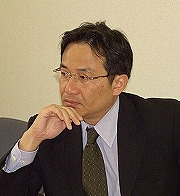 |
|
|
Column : Jounalist's Eyes
"Journalist's Eyes" , the column by the journalist of Nikkei bizTech ,Nikkei Business Publications, Inc. This article about the activities and the results of "the Institutional Management of Technology" is published once every two month.
Vol. 3 : Toward Theorization of the Japanese Style MOT with Intellectual Properties at the Core
 Management of Technology (MOT) comes from United States and can be literally translated as ügGijutu-Keieiüh in Japanese. MOT has attracted much attention in Japan obviously because the global competitiveness of Japanese manufacturers has been declining since they reached a new height of prosperity in the 1980s. How should Japanese manufacturers restore their potential strength, whose competitiveness continued to fall down in 1990s? In order to respond to this proposition, MOT, which contributed to the restoration of the US Industries, was introduced into Japan. Cost reduction is not enough for success
To the crucial question of how to restore the global competitiveness of Japanese manufacturers, Mr. Masahiro Samejima, who plays the role of COE professor at the 21st century COE program ügThe Science of Institutional Management of Technology: SIMOTüh at Tokyo Institute of Technology, has also attempted to answer the question from the perspective of an expert of intellectual properties.
After graduating from the Department of Metallurgical Engineering of Tokyo Institute of Technology and working as engineer to develop metal materials at Fujikura Electric Wire Corporation (now Fujikura Ltd.), Mr. Samejima got the qualifications of patent attorney and lawyer in a short period of time. He has a unique career, becoming independent after working at the intellectual property department of IBM Japan and several law firms. Asserting himself as a lawyer with the knowledge on both technology and business, he has been a practitioner of MOT in this respect.
Mr. Samejima explains the reasons for the declining global competitiveness of Japanese manufacturers as follows: Simply stated, if there is larger difference between price and cost of products, then there will be larger profit. When the price goes down, the difference between price and cost will be smaller; if cost is not pulled down simultaneously, profit will decrease. Japanese manufacturers had achieved the highest profitability through relentless cost reduction, even as the price was going down in the 1980s. Such cost control has been achieved through improving production process in addition to cutting the labor costs. This approach leads to reduction of cost and maintenance or even enhancement of the quality level. In terms of quality and cost control, Japanese manufacturers have been the best in the world till now. However, only with this approach the global competitiveness can not be maintained. For example, cost-wise, it is difficult to compete with China which has become dominant as the ügWorld Factoryüh because of its overwhelmingly low labor costs. Dominate the market with patents
Mr. Samejima points out that though quality and cost control is still important, there should be a third pillar in order to restore the global competitiveness.
Mr.Samejima pursues a price control mechanism as the third pillar, making the best use of intellectual property rights including patent rights. He continues. ügPatent rights are the legal exclusive rights vested to the owners of the rights. I hypothesize that if such a measure could be successfully used, it is possible to control the prices of productsüh. This idea is similar to the discussion on ügthe structure of technological hegemonyüh, the second feature article in Nikkei bizTech Vol.5. Only a small number of players with strong patents build hegemony in the market by using patents. ügMeasures to build barriers leading to monopoly or oligopoly include sales network and overwhelming capital investments. Patents are not omnipotent, but could surely be a formidable weapon.üh (Mr. Samejima) There are some companies that build a market hegemony through making use of patents. Those include Taiyo Yuden, Sony and Phillips (Netherlands) who built a patent pool of CD-R. These three firms set up the patent royalty in absolute dollar value per piece of CD-R, not percentage, which brought lucrative return to these firms. Though we donüft know the exact amount, let us say that it is 10 Yen for each piece. In 1994, the price of CD-R was 300 Yen per unit. The patent royalty ratio per price was 3.3%, and other firms were able to enter the CD-R market by paying the royalty to these three firms, therefore, the market expanded rapidly. On the other hand, the price of CD-R fell down rapidly. In 2002, the price fell down to 30 Yen per unit. The royalty ratio became 33.3%. By forming the patent pool, these three firms were able to use each otherüfs patents without royalty. Therefore, the other firms had to exit the market due to the huge cost disadvantage. This situation also blocked new entrants. At last, these three firms dominated the CD-R market. As a professor of the Science of the Institutional Management of Technology, Mr.Samejima aims to collect cases, similar to these three firms that through making the best use of intellectual property rights, with the help from students, analyze them, and theorize the business strategy. Mr.Samegima says, ügIt is not to our best benefit to simply bring and translate the MOT from U.S.üh We should pay attention to such efforts to generate the Japanese style MOT theory from the perspectives of utilization of intellectual properties. (NAKANOME,Junichi / Nikkei bizTech)
© 2005 Tokyo Institute of Technology, All Rights Reserved. |